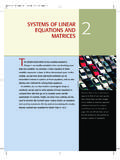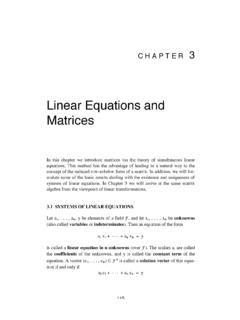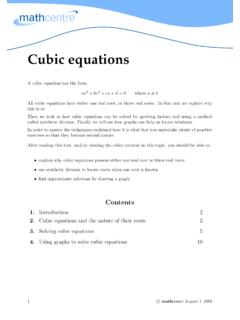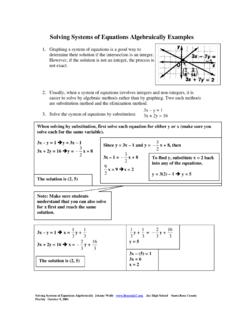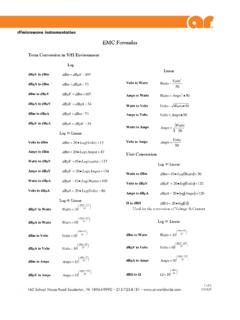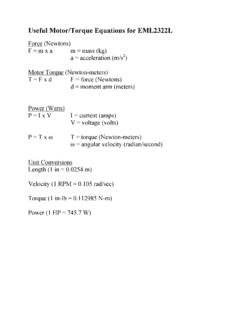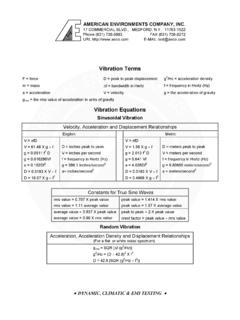Transcription of 23. Fresnel Equations - Pat Arnott Web Site
1 23. Fresnel Equations EM Waves at boundaries Fresnel Equations : Reflection and Transmission Coefficients Brewster s Angle Total Internal Reflection (TIR) Evanescent Waves The Complex Refractive Index Reflection from Metals 2222222222cossincossincossinc:ossinrTErT MEnrEnEnnrrreflection coefEnnficient ==+ + ==+ 222222coscossin2coscoss:intTEtTMttransmi ssion coefficieEtEnEntEnntn ==+ ==+ n2 EEtEr r tn1We will derive the Fresnel Equations 12nnnnnincidentdtransmitte= EM Waves at an Interface()()():exp:exp:expoioriiirrttrt otkkkIncident beamEirtReflected beamEirtTranEEsmitted beamEitEr = = = rrrrrrrrrrrr101020irtknkknkknk===rrrrTE moden1n2i n1n2TM modeNote the definition of the positive E-field directions in both cases. n2n1iErrErtErikrrkrtkroiErorErotErEM Waves at an Interface(), , points , the tangential component must be equal on both sides of the interAt the boundary between the two media the x yplane all waves must exist for all time t and fofallacboundaryr on thteerein r,rface()()()expexpexp:::ioiirorirtottrt EEi r tEEi rIncident beamReflected beamTransmitted beakkkmtEEirt = = = rrrrrrrrrrrr()( )() : Phase matching at the boundary,!
2 :ii rr ttthe only way that this can be true over the entire interfackrtk rtkrte and for all t is iAssuming that the wave amplitudes are constanft = = rrrrrr()( )()expexpexpoiiiorrrottirttnEikr tnEikrtnEiknE nE nrtE + + = = rrrrrrrrr))rrr))))n2n1iErrErtErikrrkrtkr oiErorErotEr nrrEM Waves at an InterfaceNormalxikrrkrtkr10nk20nkrr10102 0irtknkknkknk===rrr()( )()Phase matching condition:ii rr ttkrtk rtkrt = = rrrrrr (Frequency does not change at the boundary!)0,titirrAt rthis results inttt === ==r,,,, ,and ., .irirtirttkrconstantthe equation for a plane perpendicular to kkkand k are coplanar in the plane of incidencer = rrrrrrr (Phases on the boundary does not change,!)0irtAt tthiskrresults ikknrr === rrrrrrn2n1iErrErtErikrrkrtkrrrEM Waves at an Interfaceco0,,sinsinsn,sintasnntiiriirri iirtririrAt tConsidering the relation for the incident and reflected beamskr k rkrkrSince the incident and reflected beams are in tkr k rhe same mediumnkkkrc = = === = = == =rrrrrrrrrr: law of reflection,sinsinsinsin: law of refractio,nitiiitittitttiConsidering the relation for the incident and transmitted beamskr krkrkrBut the incident and transmitted beams are in different mediannkkccnn = = === rrrri r t Normalxikrrkrtkr10nk20nkrrn2 r tn1xiErrErtErikrrkrtkrDevelopment of the Fresnel Equationscosco',sco:sir tiirrttEE EBB BFrom Maxwell s EM field theorywe have the boundary conditions at the interfaceThtangentialcomponents of both E and B are equal onboth sides oe above coftheinditions imply that thfor the TeEcase += =rr0coscos.
3 , have alsoassumed thatas is true formost dielectric materianterfaceEE EBFor the TM modBBels += + = TE-caseTM-caseDevelopment of the Fresnel Equations1111221:coscos:coscosc vs coosiirir tirt tiirr ttcRecall that EBBnLet nrefractive index of incident mediumnrefractive index of refracting meFor the TM mdiuFor the TE modnEBcodeEEeEE EnEnEEnmnEnEE = == == ++=+ ==2rtnE= TE-caseTM-casen1n2n1n2 Development of the Fresnel Equations21sinsincoscos:coscoscoscos:cos co:scositrTtitEiititrTMiitfrom each set of enETE caserEnnETM caquationsand solving for the refleEliminatingction coefficient we obtainwherEnneWe know tse rEnantnnh ==+ +====+22222sin1 sin1sinittinn nn = = = TE-caseTM-casen1n2n1n2TE-caseTM-casen1n2 n1n2 Now we have derived the Fresnel Equations2222222222 cossincossi ::::ncossincossiniirTEiiiiirTMiiiSubstit uting we obtain treflection coefficiehe Fresnel equants rnErEnnnErEntransmission ctions forTE caseTM caseFor theToeffici n tnet ==+ + ==+ 222222coscossin2cos: 1:cossin 1::TETETMTtiTEiiitiTMiMiiEcaseTM caEtETEtrTMnnEntEntnser ==+ ==+= + =12nnn These just mean the boundary conditions.
4 ::ir tirtFor the TE case EEEFor the TM modeBBB+= += Power : Reflectance (R) and Transmittance (T). 1,,::triiirtR and T are the ratios of reflected and transmitThe quantitiesThe ratiosrespectively toted powersPPRTPPRTr and t are ratios of electric field amplitudesFrom conservation of enerthe incident powerPP PWe cangy===+=+ 2102000: coscos coscoscos1cos 1c22iiirrrtttiirriirrtiirrtittttiexpress the power in each of the fien terms of the product of an irradiance and areaPIA P IAPIAIldsIAI AIAB utncIIIncIA IIAEAE = =+=+ == =+=2210020022220200222002200022220100011 oscoscos22coscos 1coscoscoscoscosscoirtttiirrttrttrttiiii iiiincEn cEEnEEEEERrTnnRTEEnEEnEE ==+ = += +=+ === 2t 22coscos*coscos*tnttnTrrrRitit = === 22coscos_coscosoutoutoutoutoutininininin nEIPower ratioInE == A23-2. External and Internal Reflection()212221, /1sin0 are always realTE TMnnnnrnn >=> rTEtn= s angle (or, polarizing angle)(No reflection of TM mode)()1:tan 0 TMppfNoor thteTM casenerwhen = ==External Reflection,0TE TMr>,0TE TMr<,0TE TMt>2222222222cossinccossin coossinssiniiiTMiiTEiiinnrnnrnn + =+ =+ , If 0 then there are no phase changes after TMr >,,,, If 0 then there are always ( 180 ) phase changes.
5 TE TMTE TMTETE MiTMTrerr r <= = = o[]21/1nnn=>rTM()22,,,,, If sin0, =1, =1 (- ~) phase change may occur after reflect ion!TE TTE TMTE TMiiTE TMTEMTMBUT rare compnrrrreelex < = = +()1tan:0pTMNoBrewster's anglenfor the TMecasetr ==critical angleInternal Reflection2222222222cossinccossin coossinssiniiiTMiiTEiiinnrnnrnn + =+ =+ ,0TE TMr>,0TE TMr<Total internal reflection (TIR) when > cTIR region()()21222122/1 sin0,,sin0nnnnonnrn = < > <>()22,21 If sin0, =1 sin(/ )TE TMcnrnnn = ==()22,,, If sin0, are always real If 0 then there are no phase changes after reflection. If 0 then there are ( 180 ) phase TMTE TMTE TMnrrr > > <=o[]21/1nnn=<Derivation of Brewster s Angle()422222242221222222 2c():cossin cossossin0cossin , (1)ossitann031pppppTMpppppppppBrewster's anglefor polarizing angnnrnnFor nlennnnnncn = + + == = = +=== externalreflectioninternalreflection p p cR External & Internal reflections, but TM-polarization only1 : sin n nc<= or nn np11 : tan<>= TE & TM polarizations, but Internal reflection onlyBrewster s angle :Critical angle :TETMT otal Internal Reflection(TIR) 211, ,and for both (TE and TM) cases.
6 Sint : 11otal internal r*1 eflection() cos rTEicnInternal reflectionnnrRrrisacomplexcallnumbeFornT IderErErR =<=== == =2222222222sincossincossincossiniiiiiirTMiiiinnnnErEniini + + ==+ internalreflectionRr cComplex valueR = 1rTEn= ,0TE TMr>,0TE TMr<,0TE TMt>23-3. Phase changes on reflection,,, 18 ,,0) (TE TTE TMTE TMMthe phaseris always a real numbtheer for exphase shshift isfoift isternal reflectionthenanfor rrdr > =<TETMP hase shift after External ReflectionFor TE case, phase shift for all incident anglesFor TM case, phase shift for < pNo phase shift for > pExternal ReflectionExternal ReflectionExternal reflectionrTMc >:Complex valueIn TIR regionPhase shift after Internal ReflectionInternal reflection1 0 for sin is complex in TIR region where TETETEcTEciiTETE rnrrree > <= > = =For TM case, no phase shift for < p phase shift for p < < c TM( ) phase shift for > cFor TE case, no phase shift for < c TE( ) phase shift for > cTIRTIR1 0 for tan 0 for TMTMpTMpciTMTMTMTM rnrrrer > <= < << = = = is complex in TIR region where TMTMTMciiTMTM rrree > = =2 :cossinsintancossin2 ( ) s coiiiicTIWhenthenand for both the TE and TM cases has the formaibiebreeaibiRcaseriscomplexea + ==== === = ++22222221222cossin:cossincossinsintant ().
7 Sin2tancoan2cos s iirTEiiiiiiTiETEiis the phase shift on total internal reflection TIRninETE caserEinabnnAsimi ==+ == = = = 2212sin2tancos:iTMilar analysis for the TM case givnesn = Internal reflection:ic >:ic >TIR(Complex r )Phase shifts on total Internal Reflection for both TE- and TM-cases2212221sin2tancossin2tancosiTMiT Ennn = = Internal reflectionComplex valueTherefore, after TIR is .. ,TE TMr,TE TMr,TE TM 2222222222cossincossincossincossiniirTEi iiiirTMiiinErEnnniiinniErE ==+ + ==+ ()cincident > case TIRFor Internal reflectionTIR(Complex r )Summary of Phase Shifts on Internal Reflection'p'pc221c20 < ( 180 ) <sin2tan <cosTMinn ==< ooppcc0 < <0 TMTE = = =< > < ooc221c0 <sin2tan >cosTEin = o TM TE Fresnel RhombLinearly polarized light (45o)CircularlyPolarizedlight3 53 After two consequentive TIRs, 3 2 2 TMTEiTMTETMTEN otenearwhen nQuarter wave retarder === = = = o TM TE Linearly polarized light(45o)
8 CircularlyPolarizedlight 69 ???2 2 TMTEiTMTEN otenearwhen nQuarter wave retarder === = = o TM TE Quarter-wave retardation after TIRn23-5. Evanescent Waves at an Interface()()()():exp:exp:exp exp si:nioiiirorrrtottttottttttIncident beamEEi k rtReflected beamEEi k rtTransmitted beamEEFor the transmittedikbeartEEikrkmtrk = = = = =rrrrrrrrrrrrrrrr)()()()222cos sincossin, cos1 sin1,: sin sinc () o s 1ittttttittiWhennxkz xxzzkxzButnthia purely imaginary numbetotal internal reflectionrenn + +=+== =>)))Evanescent Waves at an Interface()222 sinsin1,:sin:sinsin211:tttitiittiwith an TIR conditionnizFor the transmitted beamwe can write the phase factor askr k xnDefining the coefficientknnWe can write the transmitted wasnvEea =+ = ==>rr() will decay rapidThe evanescent waveas it penetrates into the lower refractive indlykxEitex mednium Note that the incident and reflection wavesform a standing wave in x directionn2n1n1> n2h()0sinexpexpttttkxEEitzn = xz221 1sin21totiEEehn = == Penetration depth:Frustrated TIRTp= fraction of intensity transmitted across gapZhu et al.
9 , Variable Transmission Output Coupler and Tuner for Ring Laser Systems, Appl. Opt. 24, 3610-3614 (1985).dn1=n2= Frustrated Total Internal ReflectanceZhu et al., Variable Transmission Output Coupler and Tuner for Ring Laser Systems, Appl. Opt. 24, 3610-3614 (1985).Pellin-Broca prismd= 1 ~ : changing the reflectanceRotation: changing the wavelength resonant at Bd23-6. Complex Refractive Index22200 ( ) : 112 RIRIRIFor a material with conductivityninninnininn =+= =+=+ + %%20202224200202022:121022:11211424222 RIIRIRIIIIIIS olving for the real and imaginary components we obtainnnnnnnnnFrom the quadratic solution we obtnnnainn == = = += ++ = =.IWe need to take the positive root because n is a real numberComplex Refractive Index()()()()000exp expe xexppRkRkIISubstituting our expression for the complex refractive index back intoour expression for the electric field we obtainEEikr tEininurtcEniurtcnc = =+ = rrrrrrrr().
10 /kRThe first exponential term is oscillatoryThe EM wave propagates wurThe second exponential has a rith a veeal arglocity ofument ( ) rComplex Refractive Index()** 2exp 2expIkIkThe second term leads to absorption ofthe beam in metals due to inducinga current in the medium This causes theirradiance to decrease as the wavepropagates through the mediumnurIEE EEcnuII = = rrr r r()()0 exp24:kIIrIurcThe absorption coefficient is definednnc = == rr()()0 ex exppIkkRnuniurcrtcEE = rrrr23-7. Reflection from Metals2222222222cossin:cossincossin:coss in:iirTEiiiiirTMiiiReflection from metals is analyzedETE caserEnETM casby substituting the complex refractive index n ierEnSntheFresnelnnequaubtinnnoss ==+ + ==+ %%%%%%%()()()()()()()()()()()()222222222 2222222:cossin2:cossin22cossin 2:2cossin 2iRI i RIriiRI i RIRIRIiRIiRIriRIRIiRRIIiRITE caseTM casetitutingwe obtainnninnErEnninnnn innnninnErEnn innnnnn iinnn +==+ + ++ + == ++ += + %Reflectance iReflection from Metals at normal incidence ( i=0)()()()()()()()()2222*2222 1112 1111 1112 RIRIRIRRIRIRIRRRIRIIRIT heis given byRrrninninnnnninninn n npower reflninrniectance RnnnRnn = + ++== + +++++ +=+ =+ + 2222222222cossin11cossincossin11cossinii TEiiiiTMiinrnnnnnnrnnn ==++ + ==++ %%%%%%%%%%,0:iAt normal incidence = At normal incidence(from Hecht, page 113) visibl
